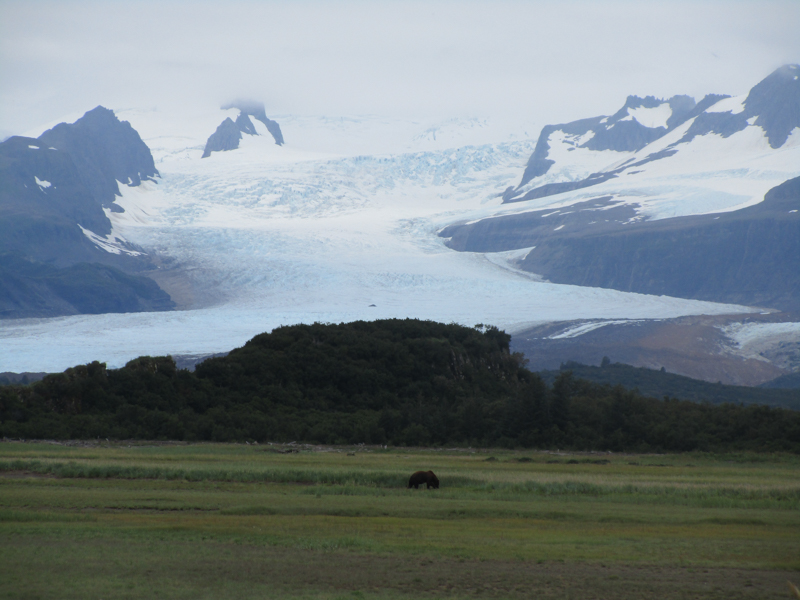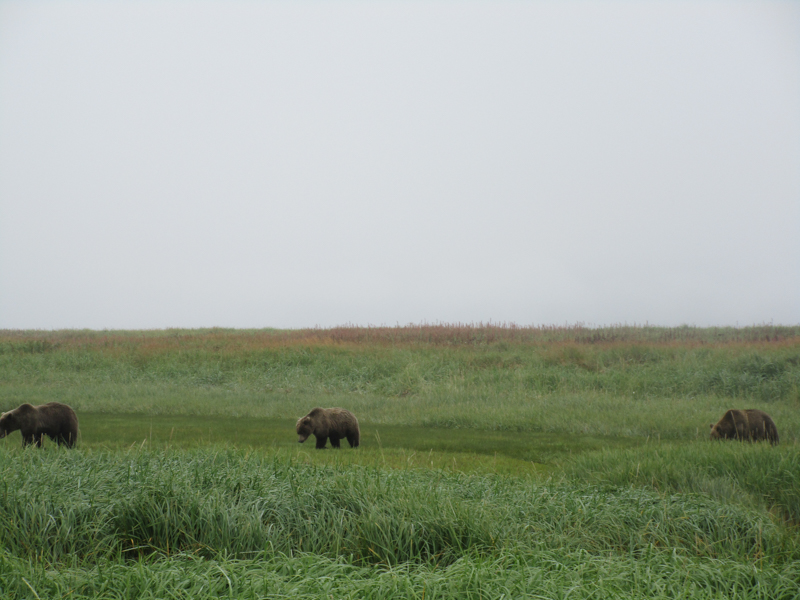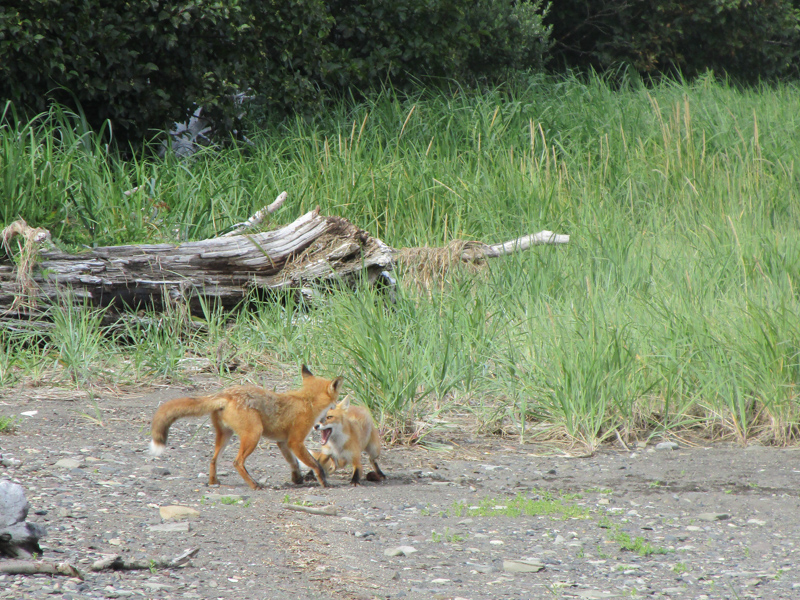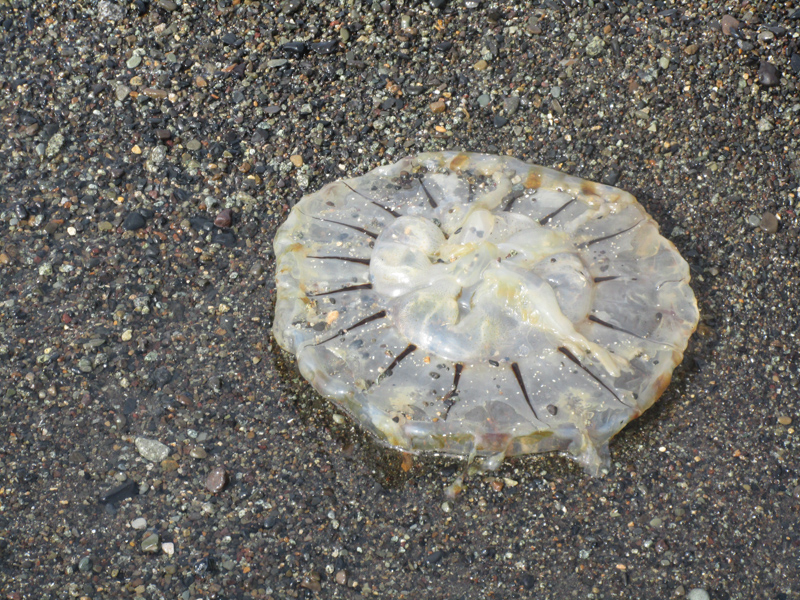“Do you guys get off the island very much?” This is a common question that rangers at Brooks Camp will get throughout the summer. Although Brooks Camp is not an actual island, but instead a peninsula dotted with lakes, it can often feel just as isolated. While Katmai National Park and Preserve covers more than four million acres, most rangers spend their entire summer in the 1.5-mile square area that is Brooks Camp. While Brooks Camp is one of the best bear viewing destinations in the world, it is just a small part of the many amazing features protected by Katmai National Park and Preserve. When I was offered to fill in for a two-week backcountry rotation at Hallo Bay, I jumped at the opportunity to see one of the lesser-known areas within the park.
 The braided Savonoski River flows from the Serpent Tongue Glacier. NPS Photo.
The braided Savonoski River flows from the Serpent Tongue Glacier. NPS Photo.
On the flight out to Hallo Bay we were privileged to see the braided Savonoski River, the Serpent Tongue Glacier, a mountain protruding out of the glacier known as the Devils Desk, as well as Hallo Glacier and its terminal lake. Many of these enormous features are not witnessed by the average visitor to Katmai yet are some of the most impressive sights on the Alaska Peninsula. The immense size of these resources gives one the sense of scale, of how much is protected by Katmai National Park and Preserve.

Hallo Glacier extends down into the valley floor. NPS Photo.
One of the first things you realize once landing in Hallo is how remote the area is. All communication is done through satellite phone and all supplies, including people, are brought in via the park plane. The camp consists of multiple all season tents and one large communal tent for cooking and storing gear.
 A bear grazes in a sedge meadow with Hallo Glacier in the background. The rocky outcropping of trees known as Nursery Rock is the current home of a wolf pack. NPS Photo.
A bear grazes in a sedge meadow with Hallo Glacier in the background. The rocky outcropping of trees known as Nursery Rock is the current home of a wolf pack. NPS Photo.
The Hallo Bay area consists of two large, open meadows that have salmon rearing streams flowing through them. Other food sources include clams on the tidal flats, sedges in the meadows, and the occasional bird or marine mammal that washes up on the shore. The combination of these many resources makes it possible for numerous bears to make a home in Hallo Bay.
 A family of bears works their way across the sedge meadows. NPS Photo.
A family of bears works their way across the sedge meadows. NPS Photo.
Access to the ocean and the large area of Hallo Bay allow for a very diverse and thriving ecosystem. While Brooks Camp is a very healthy habitat for many animals, once large populations of bears are present, many large animals get driven elsewhere in the park. In Hallo Bay, the space and abundance of resources allow for many different types of large fauna to coexist. During my rotation I was able to see bears, wolves, foxes and sea otters.
 A pair of foxes play on the beach. NPS Photo.
A pair of foxes play on the beach. NPS Photo.
All of these animals live their lives according to the ocean tides. A low tide will allow for clamming on the tidal flats and easier salmon fishing, while a high tide can block access to certain food sources. The park is hoping to better understand the relationship of the wildlife and the tides through the Changing Tides project.
 A jellyfish in Hallo bay got caught on the beach when the tide changed. NPS Photo.
A jellyfish in Hallo bay got caught on the beach when the tide changed. NPS Photo.
One fact of life for both humans and wildlife is that everything is at the will of the elements. This was reinforced to me when my 14-day tour turned into a 17-day tour due to bad weather that made flying impossible. Weather will often prevent visitors from being able to fly in and out of Hallo Bay for days at a time.
The visitors who are able to make it into the bay are treated to a very unique wildlife viewing experience. Many bears will be concentrated to certain areas that allow photographers to sit and watch them fish and graze. Bears will often follow food sources to where people are sitting which can lead to very close bear encounters. This is different than the bear viewing experiences at Brooks Camp, where most bear viewing is done at an elevated platform. The viewing platforms help to create a place to safely watch bears while also trying to reduce human impacts on the wildlife. Because there is no infrastructure like this at Hallo Bay, visitors have a responsibility to lower their impact on the bears as much as possible.
 Visitors watch as a family of bears walk by on the tidal flats.
Visitors watch as a family of bears walk by on the tidal flats.
As a human presence continues to grow throughout Alaska, it is good to know there are protected places like Hallo Bay that preserve a wilderness setting. As interest in places like Brooks Camp and Hallo Bay continue to grow, it will be the duty and the challenge of the National Park Service to protect these resources for generations to come.
While it has truly been a pleasure to call Brooks Camp my home for the last two summers, it is great to get out and see more of the park. Visiting places like Hallo Bay allows one to get a sense of the diversity of natural resources that Katmai has to offer.
